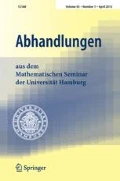Abstract
In this paper we prove that the Diophantine equation as in the title has at most one integer solution if\( \in > 5 \times 10^7 \) where\( \in = u + \upsilon \sqrt d \) is the least positive solution of Pell’s equation\(x^2 - dy^2 = - 1\)
Similar content being viewed by others
References
W. Ljunggren. Zur Theorie der Gleichung x2 +1 = Dy4. Avh. Norske Vid. Akad. Oslo1 No.5 (1942), 1–27.
M. Mignotte and M. Waldschmidt. Linear Forms in Two Logarithms and Schneider’s Method III. Ann. Fac. Sci. Toulouse, V. Sér., Math. 1989, Spec. Issue, 43–75.
L.J. Mordell. Diophantine Equations. Academic Press, New York-London 1969.
R. Steiner andN. Tzanakis. Simplifying the Solution of Ljunggren’s Equation x2 + 1 = 2y4 J. Number Theory3 No.2 (1991), 123–131.
Author information
Authors and Affiliations
Rights and permissions
About this article
Cite this article
Hua, C.J. A note on the diophantine equation x2 + 1 = dy4 . Abh.Math.Semin.Univ.Hambg. 64, 1–10 (1994). https://doi.org/10.1007/BF02940770
Received:
Revised:
Issue Date:
DOI: https://doi.org/10.1007/BF02940770


